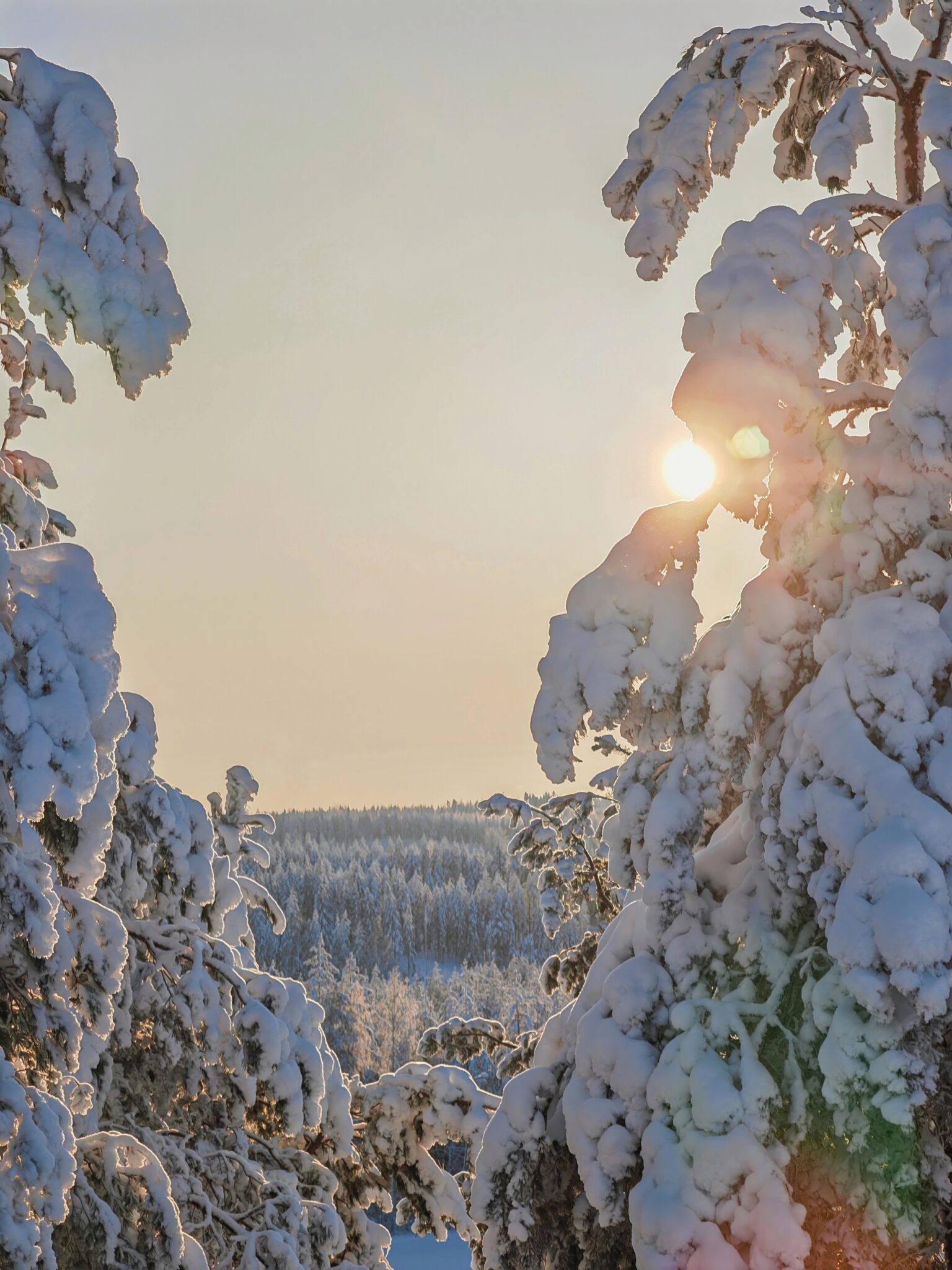Blog part 1 - life in Finland
What it's like to become a resident of Scandinavia
Hello! My name is Galyna, and I’ve been living in Finland for three years now. I am currently studying for a new profession at the South Karelia Sampo College. My specialty is "Matkailualan perustutkinto" (tourism). In this blog, I want to share what it’s like to be a girl in Finland, what my days are like, and what I’ve learned during my time living in this northern country.
The first thing that immediately stands out is the weather. It’s cold and dark here in winter, but I’ve already gotten used to the long nights and snowy streets. Finland is incredibly beautiful in the winter: white snow, frosty mornings and evenings, fresh air. I often walk outside, enjoying the silence and the beauty of nature. The forests and lakes in Finland are just stunning. In contrast, summers are warm, and the nights are almost never dark — the sun sets very late.
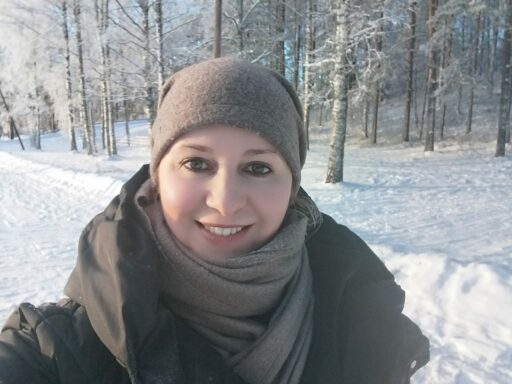
Life in Finland is different from many other countries, especially when it comes to culture. Finns really value personal space. It’s common to keep quiet on public transport and not talk to strangers without a reason. This may seem strange, but I’ve gotten used to it and learned to respect these traditions. Finns may seem reserved, but once you get to know them, they become real and loyal friends. Another important Finnish tradition is the love of sauna. Many Finns go to the sauna several times a week, and I’ve also come to love this practice. After a sauna, I feel completely refreshed!
Favourite activites
One of my favourite activities is traveling around Finland. There are so many beautiful places here! I often visit Helsinki, a city that combines ancient architecture with modern technology. But Southern Karelia, especially Imatra, Lappeenranta, and Savonlinna, is not just about nature, but also about culture. There are many historical sites here, old churches, and beautiful castles. In these places, you can feel a connection to the past, and every corner is full of history.
I also love spending time in Lapland. There, I worked as a guide for tourists from Romania, Bulgaria, Germany, and Moldova. Winter is a real adventure: reindeer safaris, husky sledding, ice fishing, and snowmobile rides. And the northern lights — that’s something unforgettable!
Life in Finland is not as hectic as in other countries. Things move at their own pace, and I really like that. Finland is one of the cleanest countries, and I’ve never seen any trash on the streets. Cities often have special containers for recycling. Finns may seem closed off, but if you show respect, they’ll open up and be very kind.
Internship in Saimaa Geopark
I’m studying at a college, and this is probably one of the most interesting and useful experiences of my life. The teaching style here is a bit different — they focus a lot on practical skills rather than just theory. As part of my studies, I have a workspace internship. I’m lucky because I’ve been accepted for an internship at SAIMAA GEOPARK ry. My supervisor, Mikko Ikävalko, went over the work plan with me, showed me where I’ll be working, and explained where all the necessary resources are — like office equipment, restrooms, materials and resources for work and other important things.
Mikko explained the tasks and goals I’m expected to accomplish, what is expected of me, and the specific assignments I will be working on. He also explained the work rules, safety procedures, and provided me with special work clothes.
Thank you for reading my blog!
Blog part 2 - Matkamessut
A Celebration of travel, inspiration, and connection in Helsinki
Every year, there is one event that becomes a true celebration for all travel enthusiasts. It’s the Matkamessut travel exhibition in Helsinki. Although it takes place only once a year, it always brings a whirlwind of emotions and inspiration. This year, I had the chance to attend this incredible exhibition, which is the largest not only in Finland but also in Northern Europe. Over 850 travel companies from 70 countries gathered here to showcase their latest ideas and innovations! It was truly something unique for me.
The exhibition took place from January 17 to 19 in the heart of Helsinki, at the Messukeskus expo center. During these three days, I was so immersed in the atmosphere that every moment brought new impressions. The air was filled with incredible positivity and energy, as well as countless opportunities for inspiration for future travels. Here, you could take part in contests, interact with people from all over the world, and discover new destinations.
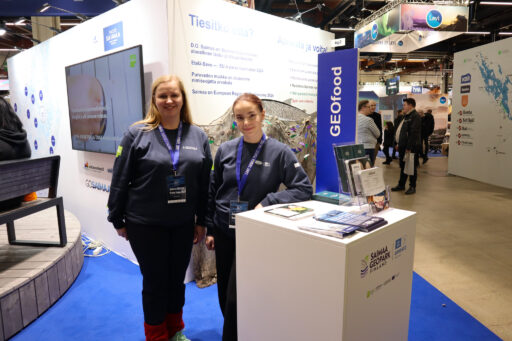
Travel fair was a memorable experience
I was fortunate to become a part of this event thanks to my internship at the Saimaa Geopark. I spent two unforgettable days (Saturday and Sunday) with my new colleagues, and the atmosphere was amazing. It was a pleasure to work with such responsive and professional people. The entire Go Saimaa team welcomed me with warmth and hospitality, and I was truly impressed by the scale of the information presented about our region – Eastern Karelia.
I would like to express my special thanks to Veera Hakkarainen, who supported, mentored, and gave me valuable advice throughout the event. My colleagues and I helped visitors by providing information about the Saimaa Geopark, inviting them to visit our incredible region. We recommended local hiking and cycling routes, road trips, and, of course, shared information about the new GEOfood brand. This brand symbolizes local products and restaurants that support sustainable agriculture while preserving the geological and cultural heritage of the region. It’s not just about promoting products – it’s about moving towards a sustainable future for local communities. As I wrapped up my participation in the exhibition, I realized how important such events are for sharing experiences, building new connections, and, of course, inspiring new travels. Participating in Matkamessut was a true revelation for me, and I am confident that even more exciting travels and encounters lie ahead!
Blog part 3 - Winter visit to Kummakivi and Ruokolahti Church
Kummakivi: experiences and observations
One of the tasks of my active work practice in Saimaa Geopark is visiting places that are under the protection of UNESCO.
A notable feature of the Saimaa Geopark is Kummakivi. Its unusual shape and balancing position attract the attention of both tourists and scientists interested in geology and natural anomalies. Including objects like Kumakivi in the Geopark highlights their significance and contributes to their preservation and popularization. This place attracts both nature lovers and those interested in geological phenomena and ancient legends.

Stone in the middle of nowhere
I have been to this wonderful place before. Kummakivi is a huge boulder, about 7 meters long, which balances on a smaller smooth rock, touching it only slightly. This unique geological formation is in Ruokolahti, in the region of South Karelia, Finland.
Kummakivi is one of the notable objects of the Saimaa Geopark. Its unusual shape and balancing position attract the attention of both tourists and scientists interested in geology and natural anomalies.
Kummakivi is believed to have been formed by glacier movement at the end of the last Ice Age, about 8,000 years ago. The retreating glaciers left behind this enormous boulder, which remained lying on the cliff in such an unusual position. Local legends attribute Kummakivi's appearance to the actions of giants, who allegedly placed the stone in this position. However, scientific research confirms its glacial origin.
Kummakivi is a popular tourist attraction and is accessible by a marked trail about 800 metres long from the nearest car park.
This is my second visit to this site. Three years ago, everything was perceived differently. Everything that I saw for the first time, I felt from the position of a tourist who saw this huge stone for the first time. It was easy to find in the summer. Roads, signs, sun, weather.
This time everything is different. Firstly, it is a winter visit. Secondly, I had different tasks. My task was not just to visit this unique place - Kummakivi - in winter. Assess the possibilities of free passage to the object, check whether all information stands are in good condition. Assess their integrity, readability and relevance of information. The information on the signs should correspond to the current situation on the route. This includes updating data on travel time, changes in the route, the presence of new objects. And also whether it is difficult to find this incredible boulder in winter.
You know, I was really interested in testing everything on myself and paying attention to details that an ordinary tourist simply doesn’t see.
Travel to Kummakivi
The road from Imatra took about an hour. It was impossible to drive straight to the parking lot where the hiking trail starts. The road was covered in snow. I left the car on the side of the road and walked. Luckily, the path was trodden. It was necessary to walk 1 km to the start of the main route. The nature of Finland is so untouched that it is a great pleasure to walk along the path, since the winter is warm this year, where there were streams, and the snow around had melted a little, the sounds of water were heard. Traces of hares were visible in the snow on the right and left. Trees felled with roots in some places. Everywhere, along the entire path, various boulders were encountered.
I can say with full confidence that, starting from the main starting point with the designation of the passage route to the object, all the stands are in good condition: integrity, readability and relevance of the information. The information on the signs corresponds to the current situation on the route. No difficulty in winter to find this incredible boulder. In winter, it is not difficult to find Kumakivi, but snow increases the travel time.
Visitors are advised to plan their trip during the warmer months, as access to the stone may be difficult in winter due to snow.
The grandeur and comfort of Ruokolahti Church
On the way back I stopped at Ruokolahti Church. It became famous thanks to the painting by Finnish artist Albert Edelfelt "On the Church Hill in Ruokolahti" (1887). It depicts parishioners in traditional Finnish costumes, making the painting a symbol of 19th-century Finnish culture. Today it is considered a national treasure.
The church is located on a hill surrounded by picturesque lakes. It and its pews are listed as significant historical objects in the Finnish cultural heritage list. It is one of the most recognizable buildings in the region.
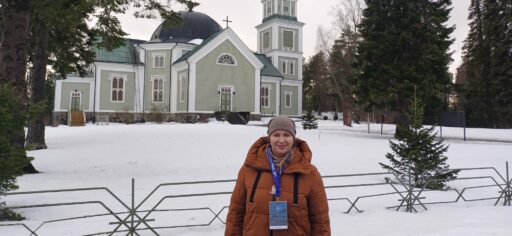
Built in 1854 according to the design of the architect Ernst Lorman, the church is a granite building in the shape of a cross, executed in the style of late classicism with elements of Finnish architecture. Its strict and majestic appearance is emphasized by a high tower with a spire, visible from afar.
The interior is decorated in light colours, with simple wooden elements and discreet decor. There is also an old organ, which is still used in worship.
The church is especially beautiful in winter: it looks like a part of a Christmas card, covered in snow. Take a walk around its surroundings, breathe in the fresh air and enjoy the peace. For photography lovers, this place will give you many bright moments. Ruokolahti Church is the perfect place to experience the harmony of nature and history. This trip will leave you with warmth and peace.
Blog part 4 - trip to savitaipale
My next work trip was to Savitaipale. My manager had set goals and objectives for me, so off I went! I recommend this trip to everyone. A scenic road, a winter fairytale come to life! Now I understand exactly where those incredibly beautiful Christmas greeting cards and nature photo calendars are made!
Savitaipale is a small but picturesque town in Finland, located in the southeastern part of the country. It is surrounded by beautiful lakes and dense forests, making it an ideal place for a nature getaway. In summer, the town comes alive with festivals and fairs, while in winter, it transforms into a cozy retreat for skiing and ice-skating enthusiasts. This is a place for those who appreciate nature and tranquility!
The Suomensalo Ridge
The first thing to note is the Suomensalo Ridge. This is a beautiful and scenic area consisting of rolling hills covered in dense forests, stretching along lakes and rivers. Here, you can find rocky elevations and winding trails leading to peaceful bodies of water. In winter, the hills take on shades of white, blue, and gray due to the mist. This place is perfect for walks, hikes, and wildlife observation. In winter, it's especially fascinating to see animal tracks in the snow—hares and deer are common here.
Kärnäkoski Fortress
Partakoski is a historic and picturesque village located on a narrow isthmus between lakes Saimaa and Kuolimo. The name "Partakoski" unites three rapids: Ahvenkoski, Saunankoski, and Siikakoski. These rapids are the only spawning grounds for lake trout in southern Saimaa.
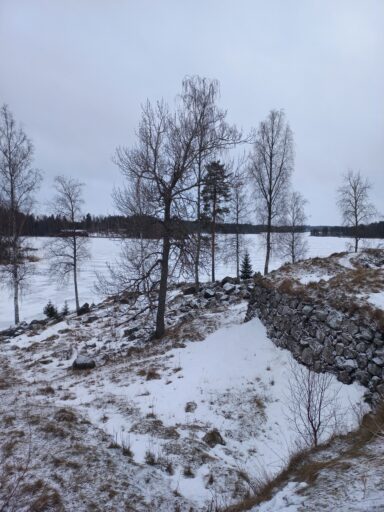 The village is home to an old granite bridge, built in 1902, as well as preserved residential and commercial buildings on both sides of the bridge. Partakoski attracts tourists with its natural beauty and cultural and historical landmarks, including the nearby Kärnäkoski Fortress. It may not be Finland's most famous fortress, but it is an important part of the country's history and a reminder of past military conflicts.
The village is home to an old granite bridge, built in 1902, as well as preserved residential and commercial buildings on both sides of the bridge. Partakoski attracts tourists with its natural beauty and cultural and historical landmarks, including the nearby Kärnäkoski Fortress. It may not be Finland's most famous fortress, but it is an important part of the country's history and a reminder of past military conflicts.
Kärnäkosken linnoitus is an ancient fortification, built over 200 years ago for defense against enemies. However, no battles ever took place here, and the fortress simply remained standing. Once, there were high earthworks, deep moats, and strong walls. Soldiers lived in barracks, storing supplies and weapons. Over time, the fortress lost its strategic importance and was abandoned. Today, only the hills and moats remain, but the place is still fascinating. Here, you can walk around, imagine how soldiers once lived, and enjoy nature. It's a piece of history you can touch with your own hands!
The Mill and Sawmill
Next to the fortress, you can see a mill and a sawmill. Although they no longer function, their legacy reminds us of the village's industrial past and the importance of water resources in the development of the local economy.
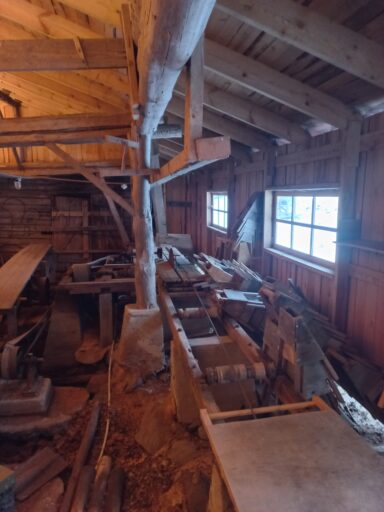
Partakoski is an example of how natural resources were used for industrial development in the past, and today, it preserves the memory of these historic enterprises. One of the highlights is the opportunity to enter the buildings, examine old equipment, and get a general idea of how things worked in the past.
Suppamaasto
In the center of Savitaipale, there is an amazing area with hills and depressions—this is suppamaasto. Long ago, a massive glacier covered this land. When it melted, large basin-like depressions remained in the earth. Now, this area is covered with beautiful forests and fields, perfect for walks and outdoor activities.
Savitaipale Rapakivi Church
In the heart of Savitaipale stands a large and beautiful church. It was built from rapakivi—a special type of stone that easily breaks into pieces. This church was constructed almost 100 years ago! With its sturdy walls and historic appearance, it is an important place for both the locals and visiting tourists. As I stepped inside, I was immediately enveloped by silence. But it was not an empty or cold silence—on the contrary, it carried an ancient force, filled with peace and anticipation. The tall stone walls reflected the soft light streaming through round stained-glass windows. On the second floor of the hall stood a grand organ. Its majestic pipes stretched upward, blending with the vaulted architecture. It seemed to be silent, yet in that silence, music was already present—subtle, barely audible, like the breath of ancient stones.
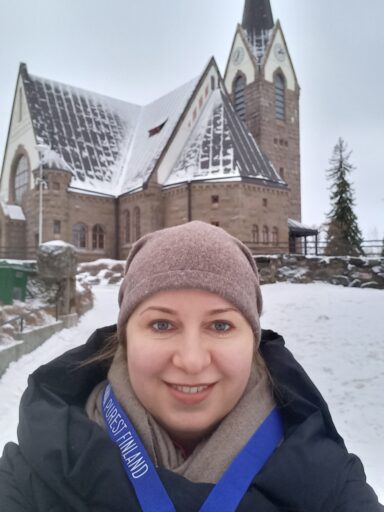
The Incredible Church
I sat on a bench and simply listened to the silence. There was something special about it, as if beyond this world, beyond the thick walls of the church, all the bustle had disappeared, leaving only a pure moment filled with beauty.
The stained-glass windows told stories—within the patterns of glass, scenes stood frozen, illuminated by sacred light. If you gazed at them long enough, you could almost see them come to life, moving, their characters stepping out of ancient tales into this silence to remind us of something important.
In this place, words were unnecessary. Light, air, stone, and the music awaiting its first notes spoke for themselves. Here, one wanted to breathe deeply, feel more clearly, and simply exist—without thoughts, without worries, in harmony with what had been created over centuries.
My belief that winter allows you to feel like a true explorer of nature and history was strengthened even more!
Blog part 5 - etelä-karjalan eräviikko
Saimaa Geopark actively participates in events aimed at protecting nature and the environment. This year, as always, the South Karelia Wild Nature Week took place - a special event that brings together children and adults in their pursuit of knowledge and respect for nature.
One of the key elements of the event was the Week of Knowledge and Skills of Local Nature, held in primary schools and kindergartens. Children learned the basics of survival in the wild, got acquainted with the flora and fauna of South Karelia, performed practical exercises in the fresh air, and learned about the region's traditions.
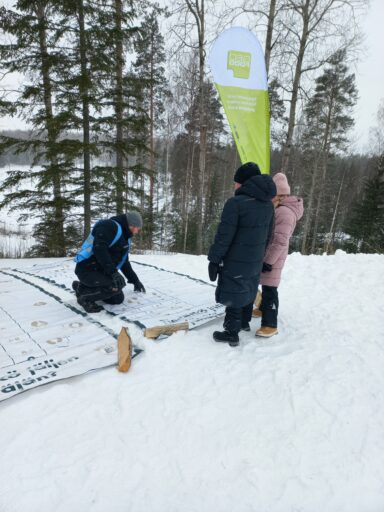 Most importantly, the Wild Nature Week provided an opportunity to implement an interdisciplinary educational module that encouraged active movement and interaction with the environment. One of the brightest traditions of South Karelia is skiing in the wild - an activity that unites people of all ages and inspires an active lifestyle.
Most importantly, the Wild Nature Week provided an opportunity to implement an interdisciplinary educational module that encouraged active movement and interaction with the environment. One of the brightest traditions of South Karelia is skiing in the wild - an activity that unites people of all ages and inspires an active lifestyle.
Eräviikko goes Freeski event
This year, I was fortunate to be part of this wonderful event thanks to my internship. Together with my boss, Mikko Ikävalko, I went to Ruokolahti, to the Laskettelukeskus Freeski ski center. The organizers gave us a warm welcome, provided us with a number indicator showing our station location, and then we participated in a general meeting, where we were reminded of safety procedures and the event schedule.
Throughout the center's territory, various stations were set up, each with its own unique activity. Visitors could try their hand at eco-gun shooting, practice hitting a ball with a bat, sledding, snowshoeing, completing a course, skiing in tandem, and even warming up in a cozy hut.
However, in my opinion, our station—animal track identification of Saimaa Geopark—was the most interesting.
Wild animal tracks
We laid out large carpets on the ground with images of wild animal tracks in Finland and information about them. One carpet was dedicated to ungulates—moose, deer, and roe deer. The second one featured predator: wolverine, bear, wolf, and lynx. The third carpet depicted squirrels, hares, and birds. Visitors eagerly studied the tracks, guessed the animals, and discussed their habits. It was especially touching to watch the children enthusiastically share their stories—some talked about seeing roe deer at their summer cottages, while others described how they leave food for squirrels in the forest.
Finland amazes me with its closeness to nature. Here, animals do not fear people, they are not threatened by hunters, and it seems that there is a special harmony between humans and nature. This day was a true gift for me—fresh air, a friendly atmosphere, and the realization that even a small contribution can help strengthen the bond between people and the natural world. A wonderful day that will stay in my memory for a long time.
Blog part 6 - on the paths of knowledge and adventure
I had little experience, but an enormous desire to develop, reach new heights, and expand my social circle. I have always wanted to tell people about things that are rarely mentioned in guidebooks, share unusual facts, and open new horizons for them.
Recently, I had a great opportunity to give a tour for my fellow countrymen at the Visitor Center of Imatra’s main library. It was a special day: not only did I share interesting facts about Finland, but I also provided insights into the structure of our planet, explaining the processes that shape our world. We embarked on a fascinating journey through South and East Karelia, exploring the history, nature, and cultural features of these regions.
At some point, the tour turned into an interactive adventure. I invited the participants to play a board game created in the Saimaa Geopark. This game was not only entertaining but also helped us better understand the unique characteristics of this remarkable place. We laughed, discussed various topics, and learned new things, creating a warm and friendly atmosphere.
That day became yet another confirmation for me that I had chosen the right path. I felt how my passion for travel and knowledge could inspire others, spark curiosity, and help people see the world from a new, unexpected perspective. But the most valuable thing is the smiles and gratitude of those I have helped discover something new.
Blog part 7 - journey to lappeenranta
My journey to Lappeenranta began early in the morning. The city greeted me with fresh air, sunshine, and beautiful landscapes. The first place we visited was the Lappeenranta Fortress. It stands on a high hill by Lake Saimaa and holds many historical stories.
A long time ago, the Swedes built it to protect their lands. Later, the fortress passed to the Russians, and soldiers, officers, and merchants lived here. Today, it is not just old walls – inside, there are museums, cozy cafes, and souvenir shops. I enjoyed walking along the cobbled streets, admiring the old buildings, and taking in the view of the lake.
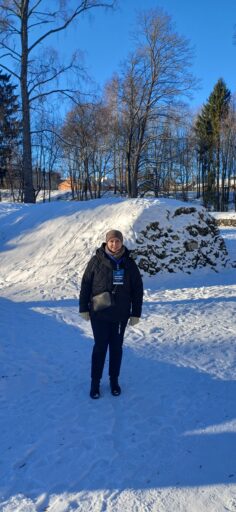
There are also many activities to do in winter. I walked along the upper part of the fortress, climbing wooden stairs that allow easy movement between levels. However, winter can be slippery, so wearing spiked shoes is essential. The old cannons near the museum were especially fascinating. I think children after school or on weekends would be thrilled to examine them and imagine themselves as soldiers from centuries past.
Lappeen kirkko Church
The next stop on my journey was Lappeen kirkko, located just a 15-minute walk from the fortress. It is one of the largest wooden churches in Finland, built in 1913 by architect Josef Stenbäck. The building looks majestic, and inside, it creates a special atmosphere. The high vaults are decorated with paintings, the wooden pews seem to remember many prayers, and a huge chandelier bathes the hall in soft light.
The church can accommodate around 2,000 people, and its organ fills the space with wonderful music. Next to the church is an old cemetery where important figures in the city's history are buried. This place is filled with memories and preserves the spirit of the past.
Lauritsala Church
The final stop of my journey was Lauritsala Church. Unlike old temples, it is an example of modern architecture. Built in 1969 by architect Arto Sipinen, it amazed us with its triangular shape. The light brick walls and large windows make it spacious and filled with light.
Inside, there are no traditional decorations, but there is a large wooden cross and an organ often used for musical performances. This church hosts not only worship services but also concerts, creating a unique atmosphere. Lauritsala Church is proof that religious buildings can look modern and innovative.
After a fulfilling day, I felt that Lappeenranta is a city where history and modernity blend harmoniously. Every place here holds its secrets and opens incredible pages of the past and present to travellers. It was a wonderful journey that left warm memories in my heart!
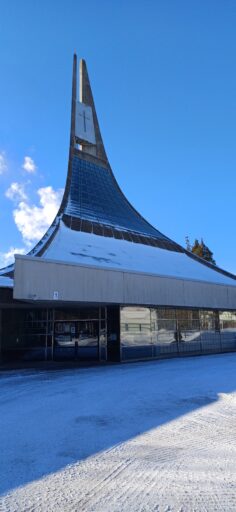
Blog part 1 - Life in Finland: What it's like to become a resident of Scandinavia
Hello! My name is Galyna, and I’ve been living in Finland for three years now. I am currently studying for a new profession at the South Karelia Sampo College. My specialty is "Matkailualan perustutkinto" (tourism). In this blog, I want to share what it’s like to be a girl in Finland, what my days are like, and what I’ve learned during my time living in this northern country.
The first thing that immediately stands out is the weather. It’s cold and dark here in winter, but I’ve already gotten used to the long nights and snowy streets. Finland is incredibly beautiful in the winter: white snow, frosty mornings and evenings, fresh air. I often walk outside, enjoying the silence and the beauty of nature. The forests and lakes in Finland are just stunning. In contrast, summers are warm, and the nights are almost never dark — the sun sets very late.

Life in Finland is different from many other countries, especially when it comes to culture. Finns really value personal space. It’s common to keep quiet on public transport and not talk to strangers without a reason. This may seem strange, but I’ve gotten used to it and learned to respect these traditions. Finns may seem reserved, but once you get to know them, they become real and loyal friends. Another important Finnish tradition is the love of sauna. Many Finns go to the sauna several times a week, and I’ve also come to love this practice. After a sauna, I feel completely refreshed!
Favourite activites
One of my favourite activities is traveling around Finland. There are so many beautiful places here! I often visit Helsinki, a city that combines ancient architecture with modern technology. But Southern Karelia, especially Imatra, Lappeenranta, and Savonlinna, is not just about nature, but also about culture. There are many historical sites here, old churches, and beautiful castles. In these places, you can feel a connection to the past, and every corner is full of history.
I also love spending time in Lapland. There, I worked as a guide for tourists from Romania, Bulgaria, Germany, and Moldova. Winter is a real adventure: reindeer safaris, husky sledding, ice fishing, and snowmobile rides. And the northern lights — that’s something unforgettable!
Life in Finland is not as hectic as in other countries. Things move at their own pace, and I really like that. Finland is one of the cleanest countries, and I’ve never seen any trash on the streets. Cities often have special containers for recycling. Finns may seem closed off, but if you show respect, they’ll open up and be very kind.
Internship in Saimaa Geopark
I’m studying at a college, and this is probably one of the most interesting and useful experiences of my life. The teaching style here is a bit different — they focus a lot on practical skills rather than just theory. As part of my studies, I have a workspace internship. I’m lucky because I’ve been accepted for an internship at SAIMAA GEOPARK ry. My supervisor, Mikko Ikävalko, went over the work plan with me, showed me where I’ll be working, and explained where all the necessary resources are — like office equipment, restrooms, materials and resources for work and other important things.
Mikko explained the tasks and goals I’m expected to accomplish, what is expected of me, and the specific assignments I will be working on. He also explained the work rules, safety procedures, and provided me with special work clothes.
Thank you for reading my blog!
Blog part 2 -Matkamessut "A Celebration of travel, inspiration, and connection in Helsinki"
Every year, there is one event that becomes a true celebration for all travel enthusiasts. It’s the Matkamessut travel exhibition in Helsinki. Although it takes place only once a year, it always brings a whirlwind of emotions and inspiration. This year, I had the chance to attend this incredible exhibition, which is the largest not only in Finland but also in Northern Europe. Over 850 travel companies from 70 countries gathered here to showcase their latest ideas and innovations! It was truly something unique for me.
The exhibition took place from January 17 to 19 in the heart of Helsinki, at the Messukeskus expo center. During these three days, I was so immersed in the atmosphere that every moment brought new impressions. The air was filled with incredible positivity and energy, as well as countless opportunities for inspiration for future travels. Here, you could take part in contests, interact with people from all over the world, and discover new destinations.

Travel fair was a memorable experience
I was fortunate to become a part of this event thanks to my internship at the Saimaa Geopark. I spent two unforgettable days (Saturday and Sunday) with my new colleagues, and the atmosphere was amazing. It was a pleasure to work with such responsive and professional people. The entire Go Saimaa team welcomed me with warmth and hospitality, and I was truly impressed by the scale of the information presented about our region – Eastern Karelia.
I would like to express my special thanks to Veera Hakkarainen, who supported, mentored, and gave me valuable advice throughout the event. My colleagues and I helped visitors by providing information about the Saimaa Geopark, inviting them to visit our incredible region. We recommended local hiking and cycling routes, road trips, and, of course, shared information about the new GEOfood brand. This brand symbolizes local products and restaurants that support sustainable agriculture while preserving the geological and cultural heritage of the region. It’s not just about promoting products – it’s about moving towards a sustainable future for local communities.
As I wrapped up my participation in the exhibition, I realized how important such events are for sharing experiences, building new connections, and, of course, inspiring new travels. Participating in Matkamessut was a true revelation for me, and I am confident that even more exciting travels and encounters lie ahead!
Blog Part 3 - Winter visit to Kummakivi and Ruokolahti Church
Experiences and observations
One of the tasks of my active work practice in Saimaa Geopark is visiting places that are under the protection of UNESCO.
A notable feature of the Saimaa Geopark is Kummakivi. Its unusual shape and balancing position attract the attention of both tourists and scientists interested in geology and natural anomalies. Including objects like Kumakivi in the Geopark highlights their significance and contributes to their preservation and popularization. This place attracts both nature lovers and those interested in geological phenomena and ancient legends.

Stone in the middle of nowhere
I have been to this wonderful place before. Kummakivi is a huge boulder, about 7 meters long, which balances on a smaller smooth rock, touching it only slightly. This unique geological formation is in Ruokolahti, in the region of South Karelia, Finland.
Kummakivi is one of the notable objects of the Saimaa Geopark. Its unusual shape and balancing position attract the attention of both tourists and scientists interested in geology and natural anomalies.
Kummakivi is believed to have been formed by glacier movement at the end of the last Ice Age, about 8,000 years ago. The retreating glaciers left behind this enormous boulder, which remained lying on the cliff in such an unusual position. Local legends attribute Kummakivi's appearance to the actions of giants, who allegedly placed the stone in this position. However, scientific research confirms its glacial origin.
Kummakivi is a popular tourist attraction and is accessible by a marked trail about 800 metres long from the nearest car park.
This is my second visit to this site. Three years ago, everything was perceived differently. Everything that I saw for the first time, I felt from the position of a tourist who saw this huge stone for the first time. It was easy to find in the summer. Roads, signs, sun, weather.
This time everything is different. Firstly, it is a winter visit. Secondly, I had different tasks. My task was not just to visit this unique place - Kummakivi - in winter. Assess the possibilities of free passage to the object, check whether all information stands are in good condition. Assess their integrity, readability and relevance of information. The information on the signs should correspond to the current situation on the route. This includes updating data on travel time, changes in the route, the presence of new objects. And also whether it is difficult to find this incredible boulder in winter.
You know, I was really interested in testing everything on myself and paying attention to details that an ordinary tourist simply doesn’t see.
Travel to Kummakivi
The road from Imatra took about an hour. It was impossible to drive straight to the parking lot where the hiking trail starts. The road was covered in snow. I left the car on the side of the road and walked. Luckily, the path was trodden. It was necessary to walk 1 km to the start of the main route. The nature of Finland is so untouched that it is a great pleasure to walk along the path, since the winter is warm this year, where there were streams, and the snow around had melted a little, the sounds of water were heard. Traces of hares were visible in the snow on the right and left. Trees felled with roots in some places. Everywhere, along the entire path, various boulders were encountered.
I can say with full confidence that, starting from the main starting point with the designation of the passage route to the object, all the stands are in good condition: integrity, readability and relevance of the information. The information on the signs corresponds to the current situation on the route. No difficulty in winter to find this incredible boulder. In winter, it is not difficult to find Kumakivi, but snow increases the travel time.
Visitors are advised to plan their trip during the warmer months, as access to the stone may be difficult in winter due to snow.
The grandeur and comfort of Ruokolahti Church
On the way back I stopped at Ruokolahti Church. It became famous thanks to the painting by Finnish artist Albert Edelfelt "On the Church Hill in Ruokolahti" (1887). It depicts parishioners in traditional Finnish costumes, making the painting a symbol of 19th-century Finnish culture. Today it is considered a national treasure.
The church is located on a hill surrounded by picturesque lakes. It and its pews are listed as significant historical objects in the Finnish cultural heritage list. It is one of the most recognizable buildings in the region.

Built in 1854 according to the design of the architect Ernst Lorman, the church is a granite building in the shape of a cross, executed in the style of late classicism with elements of Finnish architecture. Its strict and majestic appearance is emphasized by a high tower with a spire, visible from afar.
The interior is decorated in light colours, with simple wooden elements and discreet decor. There is also an old organ, which is still used in worship.
The church is especially beautiful in winter: it looks like a part of a Christmas card, covered in snow. Take a walk around its surroundings, breathe in the fresh air and enjoy the peace. For photography lovers, this place will give you many bright moments.
Ruokolahti Church is the perfect place to experience the harmony of nature and history. This trip will leave you with warmth and peace.
Blog Part 4 - Trip to savitaipale
My next work trip was to Savitaipale. My manager had set goals and objectives for me, so off I went! I recommend this trip to everyone. A scenic road, a winter fairytale come to life! Now I understand exactly where those incredibly beautiful Christmas greeting cards and nature photo calendars are made!
Savitaipale is a small but picturesque town in Finland, located in the southeastern part of the country. It is surrounded by beautiful lakes and dense forests, making it an ideal place for a nature getaway. In summer, the town comes alive with festivals and fairs, while in winter, it transforms into a cozy retreat for skiing and ice-skating enthusiasts. This is a place for those who appreciate nature and tranquility!
The Suomensalo Ridge
The first thing to note is the Suomensalo Ridge. This is a beautiful and scenic area consisting of rolling hills covered in dense forests, stretching along lakes and rivers. Here, you can find rocky elevations and winding trails leading to peaceful bodies of water. In winter, the hills take on shades of white, blue, and gray due to the mist. This place is perfect for walks, hikes, and wildlife observation. In winter, it's especially fascinating to see animal tracks in the snow—hares and deer are common here.
Kärnäkoski Fortress
Partakoski is a historic and picturesque village located on a narrow isthmus between lakes Saimaa and Kuolimo. The name "Partakoski" unites three rapids: Ahvenkoski, Saunankoski, and Siikakoski. These rapids are the only spawning grounds for lake trout in southern Saimaa.
 The village is home to an old granite bridge, built in 1902, as well as preserved residential and commercial buildings on both sides of the bridge. Partakoski attracts tourists with its natural beauty and cultural and historical landmarks, including the nearby Kärnäkoski Fortress. It may not be Finland's most famous fortress, but it is an important part of the country's history and a reminder of past military conflicts.
The village is home to an old granite bridge, built in 1902, as well as preserved residential and commercial buildings on both sides of the bridge. Partakoski attracts tourists with its natural beauty and cultural and historical landmarks, including the nearby Kärnäkoski Fortress. It may not be Finland's most famous fortress, but it is an important part of the country's history and a reminder of past military conflicts.
Kärnäkosken linnoitus is an ancient fortification, built over 200 years ago for defense against enemies. However, no battles ever took place here, and the fortress simply remained standing. Once, there were high earthworks, deep moats, and strong walls. Soldiers lived in barracks, storing supplies and weapons. Over time, the fortress lost its strategic importance and was abandoned. Today, only the hills and moats remain, but the place is still fascinating. Here, you can walk around, imagine how soldiers once lived, and enjoy nature. It's a piece of history you can touch with your own hands!
The Mill and Sawmill
Next to the fortress, you can see a mill and a sawmill. Although they no longer function, their legacy reminds us of the village's industrial past and the importance of water resources in the development of the local economy.

Partakoski is an example of how natural resources were used for industrial development in the past, and today, it preserves the memory of these historic enterprises. One of the highlights is the opportunity to enter the buildings, examine old equipment, and get a general idea of how things worked in the past.
Suppamaasto
In the center of Savitaipale, there is an amazing area with hills and depressions—this is suppamaasto. Long ago, a massive glacier covered this land. When it melted, large basin-like depressions remained in the earth. Now, this area is covered with beautiful forests and fields, perfect for walks and outdoor activities.
Savitaipale Rapakivi church
In the heart of Savitaipale stands a large and beautiful church. It was built from rapakivi—a special type of stone that easily breaks into pieces. This church was constructed almost 100 years ago! With its sturdy walls and historic appearance, it is an important place for both the locals and visiting tourists. As I stepped inside, I was immediately enveloped by silence. But it was not an empty or cold silence—on the contrary, it carried an ancient force, filled with peace and anticipation. The tall stone walls reflected the soft light streaming through round stained-glass windows. On the second floor of the hall stood a grand organ. Its majestic pipes stretched upward, blending with the vaulted architecture. It seemed to be silent, yet in that silence, music was already present—subtle, barely audible, like the breath of ancient stones.
 The Incredible Church
The Incredible Church
I sat on a bench and simply listened to the silence. There was something special about it, as if beyond this world, beyond the thick walls of the church, all the bustle had disappeared, leaving only a pure moment filled with beauty.
The stained-glass windows told stories—within the patterns of glass, scenes stood frozen, illuminated by sacred light. If you gazed at them long enough, you could almost see them come to life, moving, their characters stepping out of ancient tales into this silence to remind us of something important.
In this place, words were unnecessary. Light, air, stone, and the music awaiting its first notes spoke for themselves. Here, one wanted to breathe deeply, feel more clearly, and simply exist—without thoughts, without worries, in harmony with what had been created over centuries. My belief that winter allows you to feel like a true explorer of nature and history was strengthened even more!
Blog Part 5 - etelä-karjalan eräviikko
Saimaa Geopark actively participates in events aimed at protecting nature and the environment. This year, as always, the South Karelia Wild Nature Week took place - a special event that brings together children and adults in their pursuit of knowledge and respect for nature.
One of the key elements of the event was the Week of Knowledge and Skills of Local Nature, held in primary schools and kindergartens. Children learned the basics of survival in the wild, got acquainted with the flora and fauna of South Karelia, performed practical exercises in the fresh air, and learned about the region's traditions.
 Most importantly, the Wild Nature Week provided an opportunity to implement an interdisciplinary educational module that encouraged active movement and interaction with the environment. One of the brightest traditions of South Karelia is skiing in the wild - an activity that unites people of all ages and inspires an active lifestyle.
Most importantly, the Wild Nature Week provided an opportunity to implement an interdisciplinary educational module that encouraged active movement and interaction with the environment. One of the brightest traditions of South Karelia is skiing in the wild - an activity that unites people of all ages and inspires an active lifestyle.
Eräviikko goes Freeski event
This year, I was fortunate to be part of this wonderful event thanks to my internship. Together with my boss, Mikko Ikävalko, I went to Ruokolahti, to the Laskettelukeskus Freeski ski center. The organizers gave us a warm welcome, provided us with a number indicator showing our station location, and then we participated in a general meeting, where we were reminded of safety procedures and the event schedule.
Throughout the center's territory, various stations were set up, each with its own unique activity. Visitors could try their hand at eco-gun shooting, practice hitting a ball with a bat, sledding, snowshoeing, completing a course, skiing in tandem, and even warming up in a cozy hut.
However, in my opinion, our station—animal track identification of Saimaa Geopark—was the most interesting.
Wild animal tracks
We laid out large carpets on the ground with images of wild animal tracks in Finland and information about them. One carpet was dedicated to ungulates—moose, deer, and roe deer. The second one featured predator: wolverine, bear, wolf, and lynx. The third carpet depicted squirrels, hares, and birds. Visitors eagerly studied the tracks, guessed the animals, and discussed their habits. It was especially touching to watch the children enthusiastically share their stories—some talked about seeing roe deer at their summer cottages, while others described how they leave food for squirrels in the forest.
Finland amazes me with its closeness to nature. Here, animals do not fear people, they are not threatened by hunters, and it seems that there is a special harmony between humans and nature. This day was a true gift for me—fresh air, a friendly atmosphere, and the realization that even a small contribution can help strengthen the bond between people and the natural world. A wonderful day that will stay in my memory for a long time.
Blog part 6 - on the paths of knowledge and adventure
I had little experience, but an enormous desire to develop, reach new heights, and expand my social circle. I have always wanted to tell people about things that are rarely mentioned in guidebooks, share unusual facts, and open new horizons for them.
Recently, I had a great opportunity to give a tour for my fellow countrymen at the Visitor Center of Imatra’s main library. It was a special day: not only did I share interesting facts about Finland, but I also provided insights into the structure of our planet, explaining the processes that shape our world. We embarked on a fascinating journey through South and East Karelia, exploring the history, nature, and cultural features of these regions.
At some point, the tour turned into an interactive adventure. I invited the participants to play a board game created in the Saimaa Geopark. This game was not only entertaining but also helped us better understand the unique characteristics of this remarkable place. We laughed, discussed various topics, and learned new things, creating a warm and friendly atmosphere.
That day became yet another confirmation for me that I had chosen the right path. I felt how my passion for travel and knowledge could inspire others, spark curiosity, and help people see the world from a new, unexpected perspective. But the most valuable thing is the smiles and gratitude of those I have helped discover something new.
Blog part 7 - journey to lappeenranta
My journey to Lappeenranta began early in the morning. The city greeted me with fresh air, sunshine, and beautiful landscapes. The first place we visited was the Lappeenranta Fortress. It stands on a high hill by Lake Saimaa and holds many historical stories.
A long time ago, the Swedes built it to protect their lands. Later, the fortress passed to the Russians, and soldiers, officers, and merchants lived here. Today, it is not just old walls – inside, there are museums, cozy cafes, and souvenir shops. I enjoyed walking along the cobbled streets, admiring the old buildings, and taking in the view of the lake.

There are also many activities to do in winter. I walked along the upper part of the fortress, climbing wooden stairs that allow easy movement between levels. However, winter can be slippery, so wearing spiked shoes is essential. The old cannons near the museum were especially fascinating. I think children after school or on weekends would be thrilled to examine them and imagine themselves as soldiers from centuries past.
Lappeen kirkko Church
The next stop on my journey was Lappeen kirkko, located just a 15-minute walk from the fortress. It is one of the largest wooden churches in Finland, built in 1913 by architect Josef Stenbäck. The building looks majestic, and inside, it creates a special atmosphere. The high vaults are decorated with paintings, the wooden pews seem to remember many prayers, and a huge chandelier bathes the hall in soft light.
The church can accommodate around 2,000 people, and its organ fills the space with wonderful music. Next to the church is an old cemetery where important figures in the city's history are buried. This place is filled with memories and preserves the spirit of the past.
Lauritsala Church
The final stop of my journey was Lauritsala Church. Unlike old temples, it is an example of modern architecture. Built in 1969 by architect Arto Sipinen, it amazed us with its triangular shape. The light brick walls and large windows make it spacious and filled with light.
Inside, there are no traditional decorations, but there is a large wooden cross and an organ often used for musical performances. This church hosts not only worship services but also concerts, creating a unique atmosphere. Lauritsala Church is proof that religious buildings can look modern and innovative.
After a fulfilling day, I felt that Lappeenranta is a city where history and modernity blend harmoniously. Every place here holds its secrets and opens incredible pages of the past and present to travellers. It was a wonderful journey that left warm memories in my heart!

